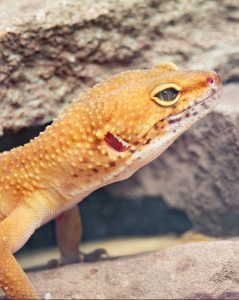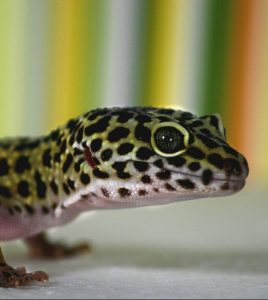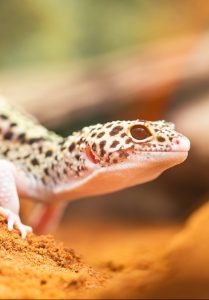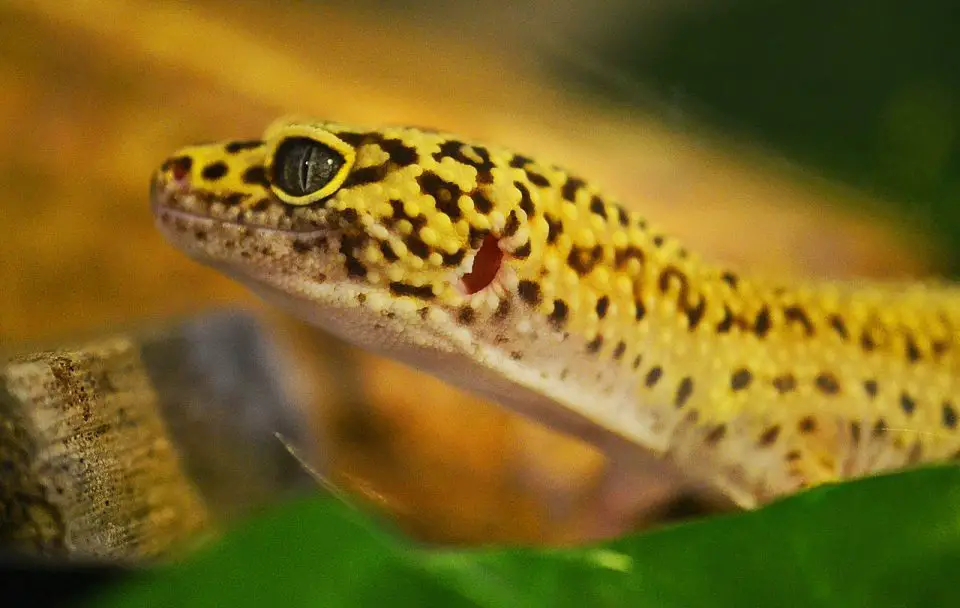Leopard geckos are fascinating nocturnal reptiles found naturally in the highlands of Asia and the deserts of the Middle East.
Their natural habitat influences their diet in a big way, even if they’re living in a terrarium in your room and not the desert.
Hi, my name is Megan, and I’ve been interested in herpetoculture – which is just a word that means keeping and raising reptiles – since I was just a little girl.
I’ve spent hours watching documentaries and reading books on different types of lizards, but leopard geckos have always been one of my favorites.
While reptiles such as the leopard gecko make just as good pets as your average dog or cat, they are very different when it comes to their diet, including how often you feed them and how much.
For first time leopard gecko owners, figuring out just how often to feed your reptile can be difficult.
That’s why I’ve made this guide to help you understand exactly what your gecko needs in his or her diet so they can live a long, healthy life with you.
How often you feed your leopard gecko depends a lot on how old they are.
How Often do you Feed a Leopard Gecko?
 Geckos that are under one year old should be fed once every day. At this age, your leopard gecko is still growing and will require the proper nutrients to grow to their full adult size.
Geckos that are under one year old should be fed once every day. At this age, your leopard gecko is still growing and will require the proper nutrients to grow to their full adult size.
After their first birthday when they become a full adult, then you can begin to feed your lizard once every other day.
There are some exceptions to this, however. If your leopard gecko falls ill, make sure to feed then every day until they are back in proper health.
What is the Best Time of day to Feed Your Leopard Gecko?
As mentioned above, in the wild, leopard geckos are nocturnal animals.
This means that, unlike humans, they wake up in the late afternoon around sunset, are awake all night, and then go back to sleep around dawn where they rest all day.
Taking that into consideration, you should try to feed your gecko around the same time that they would eat in the wild.
To help you remember, feed them right before you go to bed. This will be a good time for them and will help you remember as it will be incorporated into your nightly routine.
If you have trouble getting your leopard gecko to eat during dinner time, you can leave a small dish of food in their terrarium so that food is available when he or she decides they are hungry enough to eat.
How Much Should you Feed Your Leopard Gecko?
Feeding your leopard gecko is an interesting process.
With most reptiles, such as bearded dragons, the standard rule for feeding is to place as many insects into the enclosure that can be eaten in a 15 minute time period.
After that, the insects should be captured and removed. Feeding your gecko lizard is much more simple. Instead of feeding based on the amount of time, it goes off the size of your lizard.
A general rule of thumb is that, for every inch your leopard gecko has, you should feed him or her two insects – meaning that a 5 inch leopard gecko should be given 10 insects.
What Should you Feed Your Leopard Gecko?
 Now that you know how often and how much to feed your leopard gecko, you may be wondering what to feed him or her.
Now that you know how often and how much to feed your leopard gecko, you may be wondering what to feed him or her.
Unlike other reptiles, leopard geckos are strictly insectivores. This means that they are unable to digest fruits and vegetables and can only eat meat in the form of insects.
Their body lacks a cellum, which produces the necessary enzymes and chemicals to digest cellulose, the natural sugar found in fruits and vegetables.
They also have short, alkaline digestive tracts that, compared to those of other reptiles and even humans who have long, acid tracts, are not defined for digesting fruits and vegetables.
Find out the best food for leopard geckos here.
Foods for A Healthy Leopard Gecko Diet
Here are some examples of insects that are both safe and healthy for your leopard gecko:
Foods to Avoid
Like with any reptile, you should avoid feeding your leopard gecko any insects that light up, were found outside or around your home, or have venom such as scorpions.
Insects that light up have special natural chemicals within that produce the bioluminescent effect. When ingested, these chemicals can be toxic and harmful for your lizard.
You should also avoid feeding your gecko any insects you have caught around your home.
These insects are not bred specifically for the purpose of being sued as food, and, due to the prevalence of pesticides, could be full of harmful chemicals that can harm or even kill your leopard gecko.
Final Thoughts
 Owning and raising a leopard gecko is an amazing experience. They’re great beginner pets, and, with a lifespan of 15 years, you’ll have years of love and companionship with them.
Owning and raising a leopard gecko is an amazing experience. They’re great beginner pets, and, with a lifespan of 15 years, you’ll have years of love and companionship with them.
However, to make the most of this lifespan, it’s vital that you are giving them the proper diet and nutrients that they need.
Leopard geckos are unique even when compared to other reptiles. They need to eat once a day or every other day – depending on their age – and will only need a few insects.
They also eat in the late afternoon or early evening due to the fact that they are nocturnal animals.
A quick look at their digestive anatomy will also tell you a lot about the uniqueness of leopard geckos.
Because of how their digestive tract is and their lack of a cellum, unlike other reptiles such as bearded dragons, they cannot digest fruits and vegetables.
When you take all of this information regarding the biology of the leopard gecko and give them a proper diet of the insects they need such as crickets and mealworms, you will help them live a long, healthy life full of love and companionship.
Articles you may also like:
